MAINTENANCE AND REPAIR
ON-VEHICLE SERVICE
GENERAL A/C SYSTEM SERVICE PROCEDURES
O-ring Replacement
Important : Even though O-rings may look identical, it is extremely important that only recommended service replacement air conditioning O-rings be used, or excessive leakage of refrigerant may occur.
Important : Always slip the O-ring onto the flange tube to ensure proper locating and sealing.
Install new Daewoo-approved service replacement air conditioning O-rings whenever a joint or a fitting is disassembled, except when the O-rings are provided on new components.
When replacing O-rings on an air conditioning component or a joint connection, the fitting design should be identified to ensure installation of the correct air conditioning service replacement O-ring. Some joint connections and components will implement a "captured" O-ring design fitting that uses a groove to retain the O-ring. Others do not have a groove and use a "non-captured" or "standard" O-ring. Assembly and tightening procedures are the same for both designs, but the O-rings are different.
Before installation, verify that both O-rings and fittings have not been nicked or deformed. Deformed or nicked parts must be replaced. Failure to use the proper service replacement parts and procedures may result in excessive refrigerant leakage.
Handling Refrigerant
Caution : Always work in a well-ventilated area and avoid breathing any refrigerant fumes. If you have difficulty with breathing, seek medical attention immediately. If refrigerant comes in contact with any part of your body, flush the exposed area with water. If a rash or pain develops, seek medical attention.
Air conditioning systems contain refrigerant. This is a chemical mixture which requires special handling procedures to avoid personal injury.
Always wear goggles and wrap a clean cloth around the fittings, the valves, and the connections when performing work that involves opening the refrigerant system. Do not weld or steam clean on or near any vehicle-installed air conditioning lines or components.
All refrigerant drums are shipped with a heavy metal screw cap. The purpose of the cap is to protect the valve and the safety plug from damage. It is good practice to replace the cap after each use of the drum.
If it is necessary to transport or carry any container of refrigerant in a vehicle, do not carry it in the passenger
compartment.
Handling of Refrigerant Lines and Fittings
Notice : Using too low or too high torque when tightening a fitting can result in loose joints or deformed joint parts. Both conditions can result in refrigerant leakage.
- Keep all metal tubing lines free of dents or kinks. Any line restrictions will cause the loss of system capacity.
- Never bend a flexible hose line to a radius of less than four times the diameter of the hose.
- Never allow a flexible hose line to come within 63.5 mm (2-1/2 inches) of the exhaust manifold.
- Inspect flexible hose lines regularly for leaks or brittleness.
- Replace flexible hose lines with new lines if you find signs of deterioration or leaking.
- Discharge all refrigerant of the refrigeration system before disconnecting any fitting in the refrigeration system.
- Proceed very cautiously regardless of the gauge readings.
- Open the fittings very slowly.
- Keep your face and your hands away from the fitting so that you will not be injured if there happens to be liquid refrigerant in the line.
- If you notice pressure when you loosen a fitting, allow the pressure to bleed off as described under "Discharging, Adding Oil, Evacuating and Charging Procedures for A/C System"
in this section.
- Cap or tape any refrigerant line immediately after it is opened. This will prevent the entrance of moisture and dirt, which can cause internal compressor wear or plugged lines in the condenser, the evaporator core, the expansion valve, or the compressor inlet screens.
Important : Use two proper wrenches to connect the O-ring fittings.
- Back up the opposing fitting to prevent distortion of the connecting lines or the components.
- Back up both the swaged fitting on the flexible hose connections and the coupling to which it is attached with two wrenches to prevent turning the fitting and damaging the ground seat.
- Keep the O-rings and the seats in perfect condition. A burr or a piece of dirt may cause a refrigerant leak.
- Dip new O-rings in clean polyalkaline glycol (PAG) refrigerant oil before installation.
Maintaining Chemical Stability In the Refrigeration System
The efficient operation and life of the air conditioning system is dependent upon the chemical stability of the refrigeration system. When foreign materials, such as dirt, air, or moisture, contaminate the refrigeration system, they will change the stability of the refrigerant and the polyalkaline glycol (PAG) compressor oil. They will also affect the pressure-temperature relationship, reduce efficient operation, and can possibly cause interior corrosion and abnormal wear of moving parts.
Observe the following practices to ensure chemical stability in the system:
- Wipe away dirt or oil at and near any connection before opening that connection. This will reduce the chance of dirt entering the system.
- Cap, plug, or tape both sides of a connection as soon as possible after opening the connection. This will prevent the entry of dirt, foreign material, and moisture.
- Keep all tools clean and dry, including the manifold gauge set and all replacement parts.
- Use a clean and dry transfer device and container to add PAG refrigerant oil. This will ensure that the oil remains as moisture-free as possible. Refer to "Discharging, Adding Oil, Evacuating and Charging Procedures for A/C System"
in this section.
- Have everything you need ready to allow you to perform all operations quickly when opening an A/C system. Do not leave the A/C system open any longer than necessary.
- Evacuate and recharge any A/C system that has been opened. Refer to "Discharging, Adding Oil, Evacuating and Charging Procedures for A/C System" in this section for the instructions to perform this procedure properly.
All service parts are dehydrated and sealed before shipping. They should remain sealed until just before making connections. All the parts should be at room temperature before uncapping. This prevents condensation of moisture from the air from entering the system. Reseal all parts as soon as possible if the caps have been removed but the connections cannot be made promptly.
Discharging, Adding Oil, Evacuating, and Charging Procedures for A/C System
Caution :
Use only refillable refrigerant tanks that are authorized for the charging station being used. The use of other tanks may cause personal injury or void the warranty. Refer to the manufacturer's instructions for the charging station.
Caution :
To avoid personal injury, always wear goggles and gloves when performing work that involves opening the refrigeration system.
A charging station discharges, evacuates, and recharges an air conditioning system with one hook-up. Filtering during the recovery cycle together with filtering during the evacuation cycle ensures a supply of clean, dry refrigerant for A/C system charging.
Notice :
- Never use the R-134a charging station on a system charged with R-12. The refrigerants and the oils are not compatible and must never be mixed in even the smallest amount. Mixing refrigerant residue will damage the equipment.
- Never use adapters which convert from one size fitting to another. This will allow contamination which may cause system failure.
Charging Station Setup and Maintenance
Refer to the manufacturer's instructions for all initial setup procedures and all maintenance procedures. There are many charging stations available. All perform the various tasks required to discharge the system and recover refrigerant, evacuate the system, add a measured amount of oil, and recharge an air conditioning system with a measured amount of refrigerant.
Control Panel Functions
A charging station will have controls and indicators to allow the operator to control and monitor the operation in progress. Refer to the manufacturer's instructions for details. These can be expected to include:
- Main Power Switch - The main power switch supplies electrical power to the control panel.
- Display -The display shows the time programmed for vacuum and the weight of the refrigerant programmed for recharging. Refer to the manufacturer's instructions for detailed programming information.
- Low-Side Manifold Gauge - This gauge shows the system's low-side pressure.
- High-Side Manifold Gauge - This gauge shows the system's high-side pressure.
- Controls - This will contain the controls that control various operating functions.
- Low-Side Valve -This valve connects the low side of the A/C system to the unit.
- Moisture Indicator - This indicator shows if the refrigerant is wet or dry.
- High-Side Valve - This valve connects the high side of the A/C system to the unit.
Refrigerant Recovery
Important : Use only a refrigerant tank that is designed for the charging station in use. The unit's overfill limitation mechanism is calibrated specifically for use with this tank. The tank's valves are also specifically for this unit.
- Attach the high-side hose with the quick disconnect coupler to the high-side fitting of the vehicle's A/C system.
- Open the coupler valve after attachment.
- Attach the low-side hose with the quick disconnect coupler to the low-side fitting of the vehicle's A/C system.
- Open the coupler valve after attachment.
- Check the high-side and the low-side gauges on the unit's control panel in order to ensure that the A/C system has pressure. If there is no pressure, there is no refrigerant in the system to recover.
Important : If there is no refrigerant in the system, do not continue with the recovery operation. This will draw air into the recovery tank.
- Open both the high-side and the low-side valves.
- Open the gas and the liquid valves on the tank.
- Drain any oil that may be in the oil separator.
- Close the oil drain valve.
- Plug the unit into the proper voltage outlet.
- Turn on the main power switch.
Notice : Never reuse refrigerant oil. Damage to the A/C system may result. Dispose of the refrigerant oil properly.
- Begin the recovery process. Refer to the manufacturer's instructions for the charging station in use.
Important : Some A/C system PAG lubricating oil may be removed with the refrigerant during recovery. The amount of oil removed varies. A charging station separates the oil from the refrigerant and allows a means of determining how much oil was removed. Replace the same amount of oil when you recharge the system. Refer to the manufacturer's instructions for the charging station in use.
- Wait 5 minutes. Check the control panel low-side gauge. If the A/C has maintained vacuum, the recovery is complete.
- There is more refrigerant in the system if the low side gauge pressure rises above zero. Recover the additional refrigerant. Repeat this step until the system maintains vacuum for two minutes.
Important : If the control indicator shows that the refrigerant tank is full during the recovery process and the unit shuts off, install an empty unit tank to store the refrigerant needed for steps later in the procedure. Do not use any other type of tank.
Evacuation
The unit tank must contain a sufficient amount of R-134a refrigerant for charging. Check the amount of refrigerant in the tank. If there is less than 3.6 kg (8 pounds) of refrigerant, add new refrigerant to the tank. Refer to the manufacturer's instructions for adding refrigerant.
- Verify that the high side and the low side hoses are connected to the A/C system. Open both the high side and the low side valves on the unit's control panel.
- Open both the gas and the liquid valves on the tank.
Important : Refer to the manufacturer's instructions for the charging station in use. It is necessary to evacuate the system before recharging it with new or recycled refrigerant.
- Start the vacuum pump and begin the evacuation process. Non-condensable gases (mostly air) are automatically vented from the tank during the recycling process. You may hear the pressure being released.
- Check for leaks in the system. Refer to the manufacturer's instructions for the charging station in use.
Important : Change the vacuum pump oil frequently. Refer to the manufacturer's instructions for the charging station in use.
A/C System Oil Charge Replenishing
Any oil removed from the A/C system during the recovery process must be replenished at this time.
- Use the correct graduated bottle of PAG oil for the R-134a system.
- Use the correct graduated bottle of PAG oil for the R-134a system.
Important :
- Keep the oil bottles tightly capped at all times to protect the oil from moisture and contamination.
- Never open the oil injection valve while there is positive pressure in the A/C system. This will result in oil blow-back through the bottle vent. You must have A/C system vacuum for this operation.
- Never let the oil level drop below the pick-up tube while charging or replenishing the system. This will allow air into the A/C system.
- Refer to the manufacturer's instructions for the charging station in use. Add the proper amount of PAG oil to the system.
- Close the valve when the required oil charge has been pulled into the system.
Charging
Important : Evacuate the air conditioning system before charging.
- Close the low-side valve on the control panel.
- Open the high-side valve on the control panel.
- Refer to the manufacturer's instructions for the charging station in use.
- Enter the amount of refrigerant needed to charge the A/C. Be sure that you are using the correct system of measurement (kg, lb).
- Begin the charging process.
Successful Transfer Complete
- Close the high-side valve on the unit's control panel. Both valves should be closed.
- Start the vehicle and the A/C system.
- Let the engine run until the readings on the high-side and low-side gauges stabilize.
- Compare the readings to the system specifications.
- Check the evaporator outlet temperature to ensure that the A/C system is operating within the system specifications.
- Keep the A/C running.
- Close the high side coupler valve.
- Disconnect the high-side hose from the vehicle.
- Open the high-side and low-side valves on the control panel.
- The system will quickly draw in refrigerant from both hoses through the low-side hose.
- Close the low-side coupler valve.
- Disconnect the low-side hose from the vehicle.
Unsuccessful Transfer
Sometimes the total charge does not transfer into the A/C system. There are two reasons why this may occur.
- The pressure in the unit's tank and the pressure in the A/C system are roughly equal. This will cause the transfer to proceed too slowly. Refer to the manufacturer's instructions for the charging station in use.
- There was not enough refrigerant in the unit's tank to transfer the full charge. It is necessary to recover the partial charge of refrigerant from the vehicle and evacuate and charge the A/C system again. Refer to the manufacturer's instructions for the charging station in use.
SERVICEABLE COMPONENTS
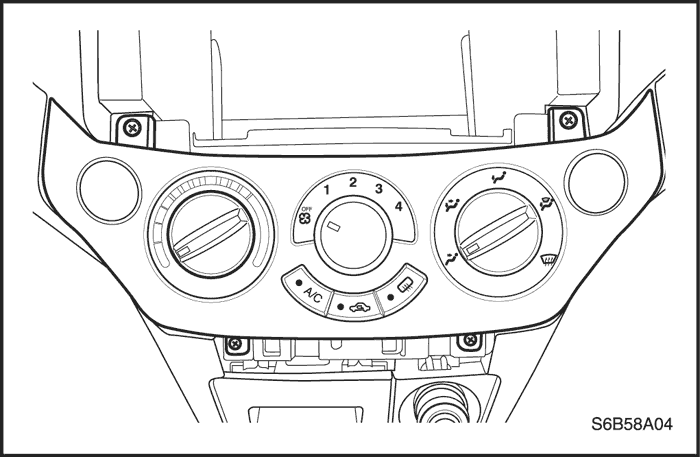


HVAC Cables
Removal Procedure
- Disconnect the negative battery cable.
- Remove the audio system. Refer to Section 9F, Audio Systems.
- Remove the HVAC controller. Refer to "Control Assembly"
in this section.
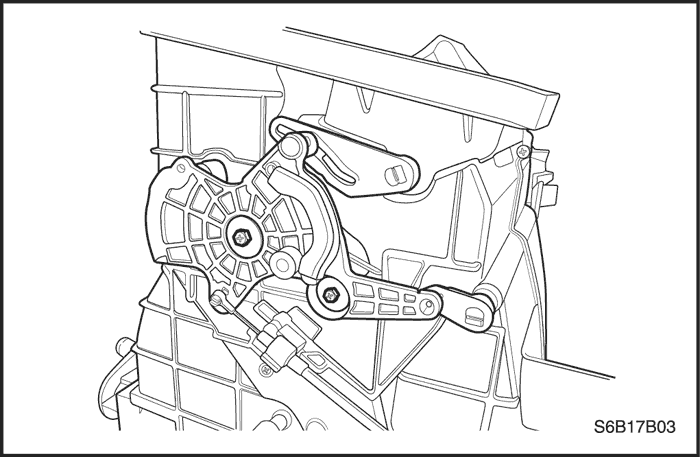


- Disconnect the heater/defrost cable eyelet from the post.
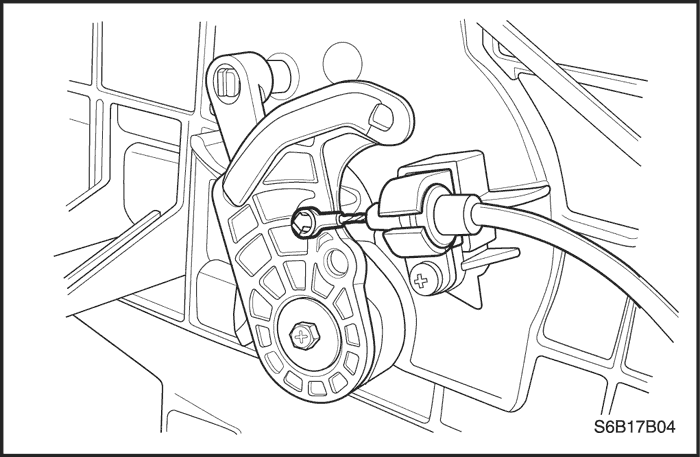


Installation Procedure
- Connect the vehicle heater/defrost cable eyelet to the post and the cable housing to the slide.
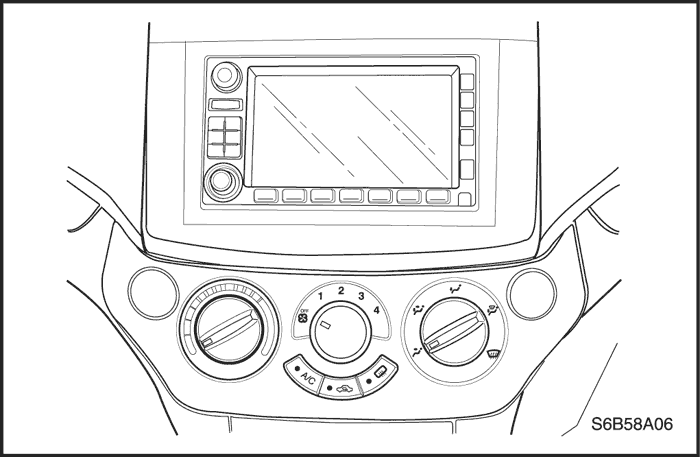


- Install the HVAC controller. Refer to "Control Assembly"
in this section.
- Install the audio system. Refer to Section 9F, Audio Systems.
- Install the dash end panel.
- Connect the negative battery cable.
- Operate the heating/cooling systems to verify proper function.
Temperature Cable Adjustment
Because the cable and the cable housings have fixed lengths, it is impossible to make a temperature cable adjustment.
The heater/air distribution case linkage also cannot be adjusted.
If a malfunction is suspected, verify the proper operation of the controller and the mechanical doors for the heater/air distributor case assembly.



Control Assembly
Removal Procedure
- Disconnect the negative battery cable.
- Remove the audio system. Refer to Section 9F, Audio Systems.
- Remove the lower left and right controller retaining screws.
- Pull out the controller to provide clearance for cable removal.
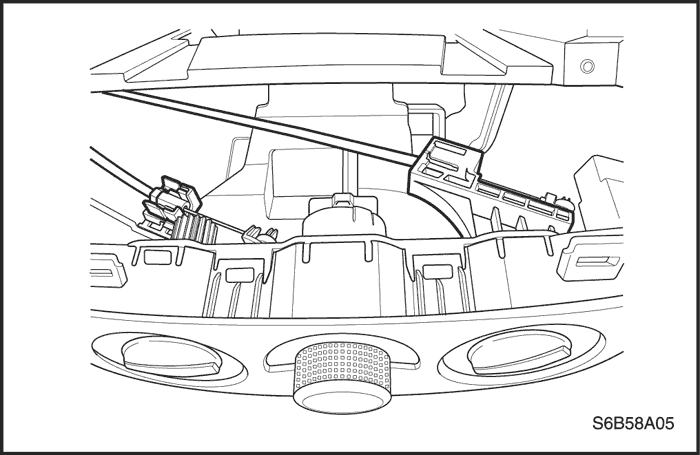


- Disconnect the mechanical control cables by gently prying the cable eyelet off. Unsnap the cable housing from the mechanical slide. Note the location of the cables and the housings for ease of installation.
- Disconnect the electrical connectors.



Installation Procedure
- Connect the electrical connectors to the sockets on the back of the controller.



- Attach the mechanical cable housings to their original control positions.
- Press the cable end eyelet onto the post.
- Gently insert the controller into position on the center console.
- Install the lower left and right retaining screws.
Tighten
Tighten the control assembly retaining screws to 3 N•m (27 lb-in).
- Install the audio system. Refer to Section 9F, Audio Systems.
- Connect the negative battery cable.
- Connect the negative battery cable.
- Operate all of the positions of the controller to ensure proper function.
- Operate all of the positions of the controller to ensure proper function.
Blower Motor
Blower Motor Resistor
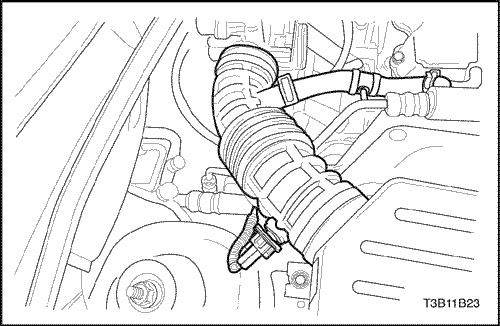


A/C Pressure Transducer
Removal Procedure
- Disconnect the negative battery cable.
- Remove the air cleaner housing bolts and the air fillter housing assembly.
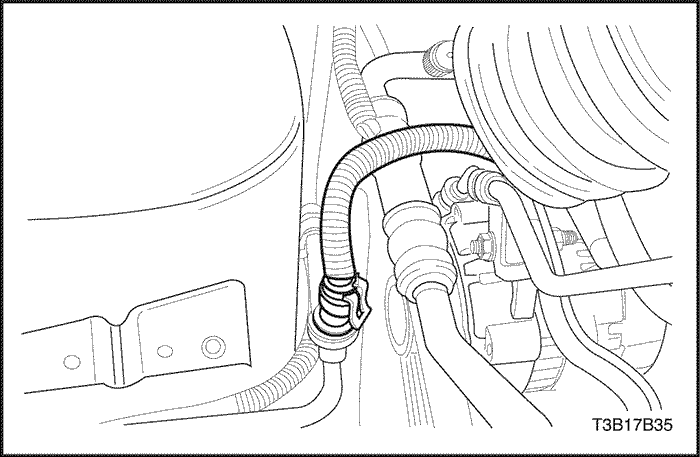


- Release the connector lock and pull the air conditioning(A/C) pressure transducer wire connector out.
- Hold the line fitting boss with one wrench and remove the A/C pressure transolucer with another wrench.
- Discard the O-ring seal.



Installation Procedure
- Install the new seal on the A/C pressure transducer.
- Install the A/C pressure transducer.
Tighten
Tighten the pressure transducer (using two wrenches) to 8 N•m (71 lb-in).
- Install the electrical connector.



- Install the air cleaner housing bolts and the air fillter housing assembly.
Tighten
Tighten the air cleaner housing assembly retaining bolts to 12 N•m (106 lb-in).
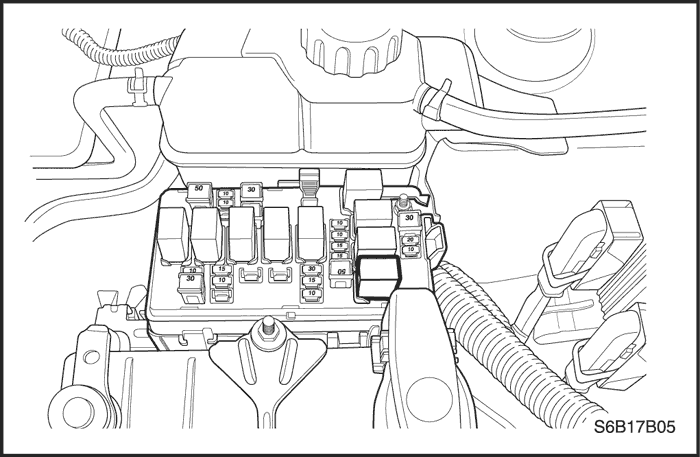


A/C Compressor Relay
Removal Procedure
- Disconnect the negative battery cable.
- The relay is located in the fuse junction box in the engine compartment on the right-hand side.
- Pull the relay straight up and out.



Installation Procedure
- Align the relay terminal contacts with the base receptacle.
- Push the relay into the base until it is seated.
- Connect the negative battery cable.



A/C Expansion Valve
Removal Procedure
- Disconnect the negative battery cable.
- Recover the refrigerant. Refer to "Discharging, Adding Oil, Evacuating, and Charging Procedures for A/C System"
in this section.
- Remove the liquid evapoator pipe connector block retaining nut at the fire wall.



- Remove the expansion valve connector block retaining bolts.
- Remove the expansion valve.
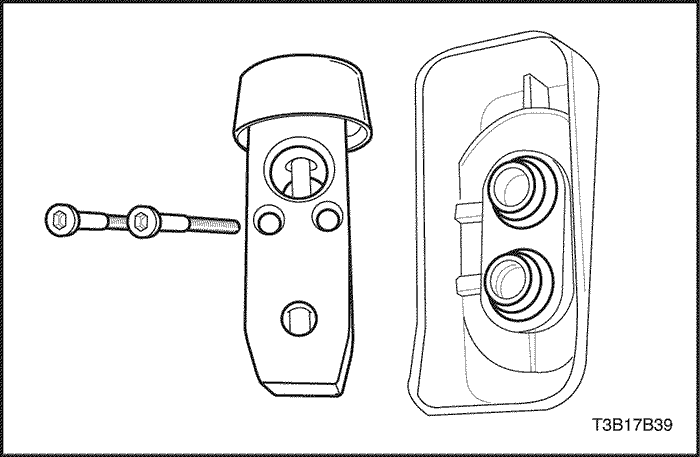


- Discard the O-rings.



Installation Procedure
- Clean the O-ring surface areas of dirt or contamination.
- Install new O-rings on the evaporator tubes.
- Install a new expansion valve onto the evaporator tubes.
- Install the expansion valve retaining bolts.
Tighten
Tighten the expansion valve retaining bolts to 12 N•m (106 lb-in).



- Install the liquid evapoator pipe connecting block retaining nut at the fire wall.
Tighten
Tighten the liquid evapoator pipe connecting block retaining nut to 15 N•m (11 lb-in).
- Connect the negative battery cable.
- Evacuate and recharge the system. Refer to "Discharging, Adding Oil, Evacuating, and Charging Procedures for A/C System" in this section.
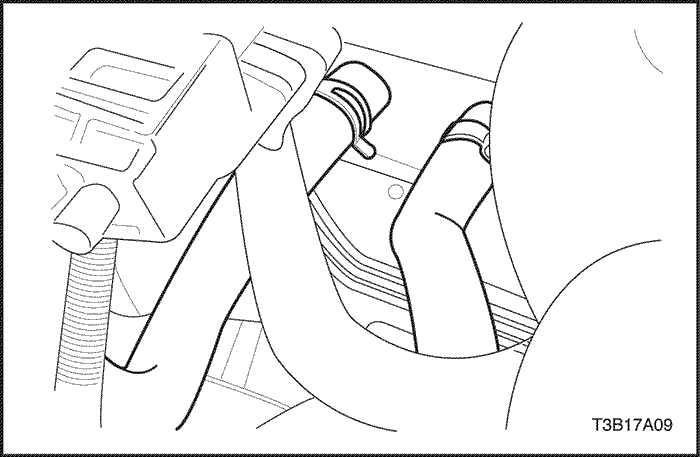


Heater/Air Distribution Case Assembly
Removal Procedure
- Disconnect the negative battery cable.
- Remove the instrument panel carrier assembly. Refer to Section 9E, Instrumentation/Driver Information.
- Drain the cooling system. Refer to Section 1D, Engine Cooling.
- Recover the refrigerant. Refer to "Discharging, Adding Oil, Evauating, and Charging Procedures for A/C System"
in this section
- Compress the heater hose clamps at the fire wall and slide the clamps toward the engine.
- Remove the two heater hoses from the core lines at the fire wall.
- Turn the condensation drain hose and pull the hose off.



- Remove the nuts that secure the A/C suction hose and liquid evaporator pipe connector block at the fire wall.
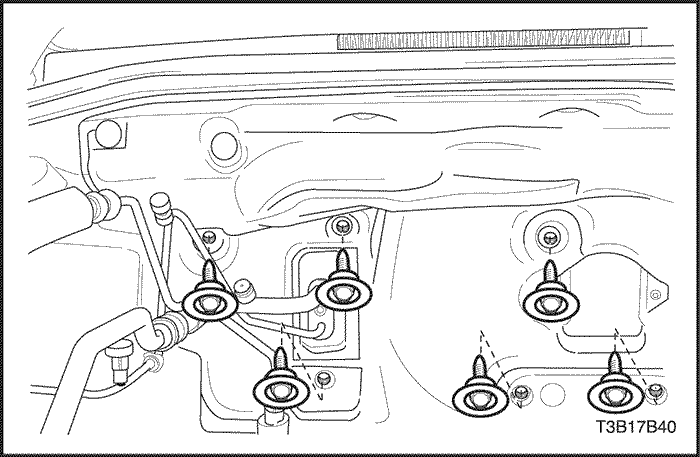


- From the engine side of the fire wall, remove the screws that secure the heater/air distribution case assembly to the fire wall.
- Remove the heater/air distribution case assembly from the vehicle.



Installation Procedure
- Clean the O-ring surface areas of dirt and contamination.
- Install two new O-rings onto the A/C suction hose and the liquid evaporator pipe at the fire wall in the engine compartment.
- Install the heater/air distribution case assembly and tighten the screws.
Tighten
Tighten the heater/air distribution case assembly retaining screws (fire wall side) to 4 N•m (35 lb-in).



- Install the A/C suction hose and liquid evaporator pipes onto the evaporator flange connector block and tighten the nut.
Tighten
Tighten the liquid evaporator pipe connector block nut to 15 N•m (11 lb-ft).



- Connect the two heater hoses to the heater core tubes.
- Slide the heater hose clamps into position.
- Install the case condensation drain hose.
- Install the instrument panel carrier assembly. Refer to Section 9E, Instrumentation/Driver Information.
- Fill the cooling system.
- Connect the negative battery cable.
- Evacuate and recharge the A/C system. Refer to "Discharging, Adding Oil, Evacuating, and Charging Procedures for A/C System"
in this section.
- Operate the HVAC control to verify the proper function of the heating and cooling systems.
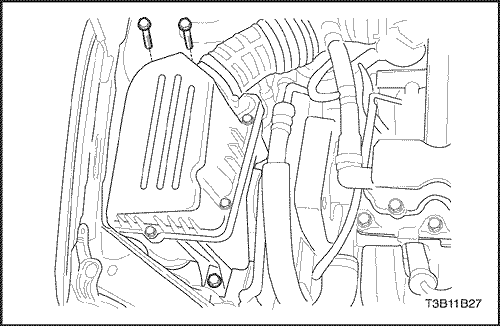


A/C High-Pressure Line
Removal Procedure
- Disconnect the negative battery cable.
- Recover the refrigerant. Refer to "Discharging, Adding Oil, Evacuating, and Charging Procedures for A/C System"
in this section.
- Remove the air cleaner housing bolts and the air filter housing assembly.



- Disconnect the electrical connector at the pressure transducer.



- Remove the liquid evapoator pipe connector block retaining nut at the fire wall.
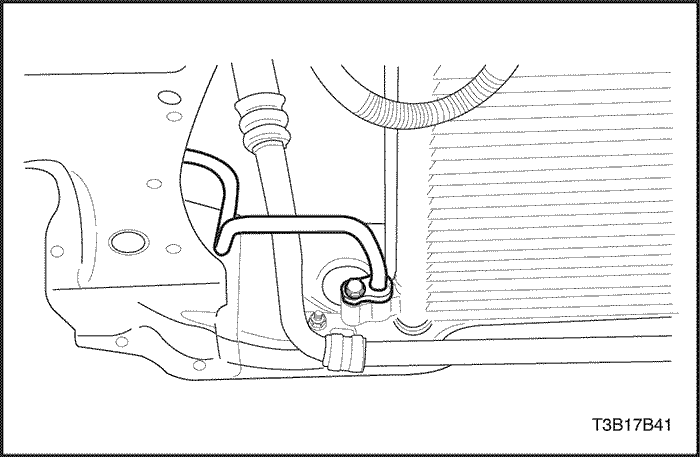


- Remove the liquid pipe connector block to condenser retaining bolt.
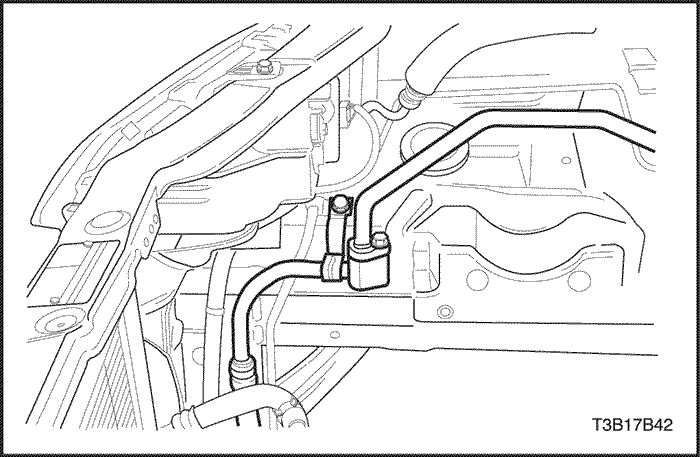


- Remove the refrigerant suction hose to liquid pipe block retaining nut.
- Remove the liquid evapoator pipe support clamp bolt.
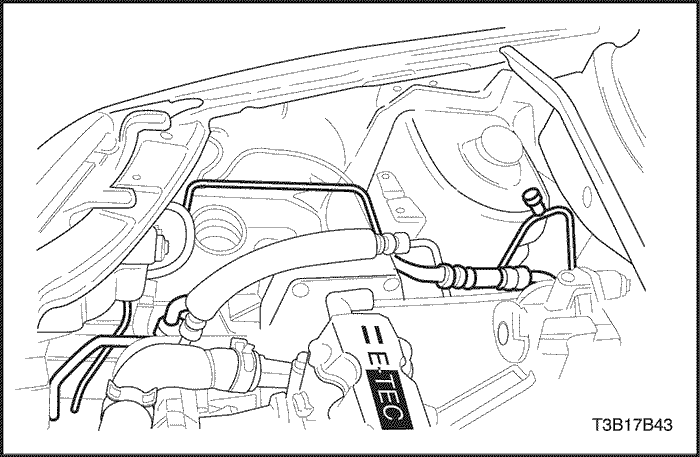


- Remove the liquid evapoator pipe and the refrigerant suction hose.
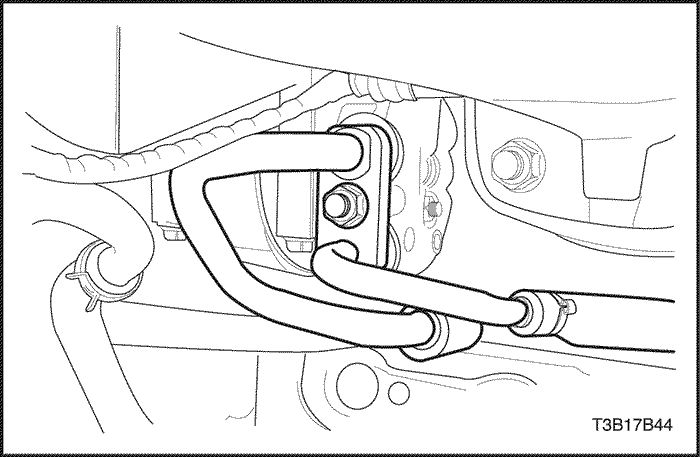


- Remove the refrigerant suction hose and the refrigerant dischange hose to compressor connector block retaining nut. (V5 Compressor shown, SP10 Compressor similar)
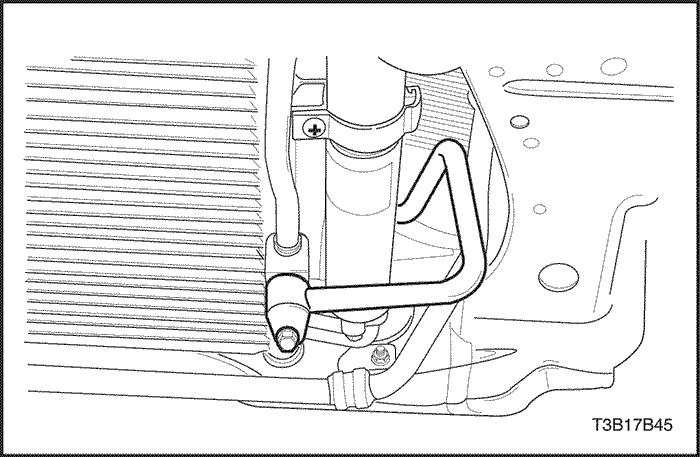


- Remove the refrigerant discharge hose connector block bolt at the condenser.
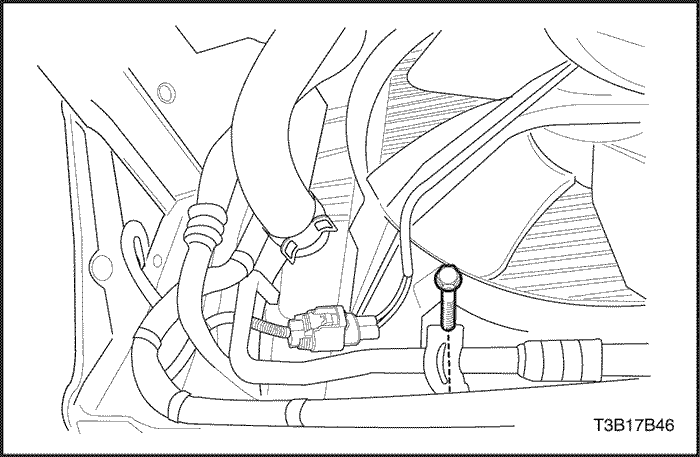


- Remove the refrigerant discharge hose support clamp bolt.
- Remove the refrigerant discharge hose.



Installation Procedure
- Position the refrigerant suction hose section into the vehicle.
- Install a new O-ring on the connector block at the condenser.
- Install a new O-ring at the liquid condenser to evaporator plate pipe connector block.
- Install the refrigerant discharge hose support clamp bolt.
Tighten
Tighten the refrigerant discharge hose support clamp bolt to 8 N•m (71 lb-in).



- Install the refrigerant discharge hose connector block bolt at the condenser.
Tighten
Tighten the refrigerant discharge hose connector block bolt to 16 N•m (12 lb-ft).



- Install the refrigerant suction hose and the refrigerant discharge hose to compressor connector block retaining nut. (V5 Compressor shown, SP10 Compressor similar)
Tighten
- Tighten the refrigerant suction hose and the refrigerant discharge hose to compressor block retaining nut to 33 N•m (24 Ib-ft) (V5 Compressor only)
- Tighten the refrigerant suction and the refrigerant discharge hose to compressor block retaining bolts to 33 N•m (24 Ib-ft) (SP10 Compressor only)



- Install the refrigerant suction hose connector block retaining nut.
Tighten
Tighten the refrigerant suction hose connector block retaining nut to 15 N•m (11 lb-ft).



- Install the liquid pipe connector block to condenser retaining bolt.
Tighten
Tighten the liquid pipe connector block to condenser retaining bolt to14 N•m (10 lb-ft).



- Install the liquid evapoator pipe connector block retaining nut at the fire wall.
Tighten
Tighten the liquid evapoator pipe connector block retaining nut to 15 N•m (11 lb-ft).



- Connect the electrical connector to the pressure transducer.



- Install the aircleaner housing assembly with the retaining bolts.
Tighten
Tighten the air cleaner housing assembly retaining bolts to 12 N•m (106 lb-in).
- Connect the negative bettary cable.
- Excuate and recharge the A/C system. Refer to "Discharging, Adding Oil, Evacuating, and Charging Procedure for A/C System"
in this section
Heater Hoses
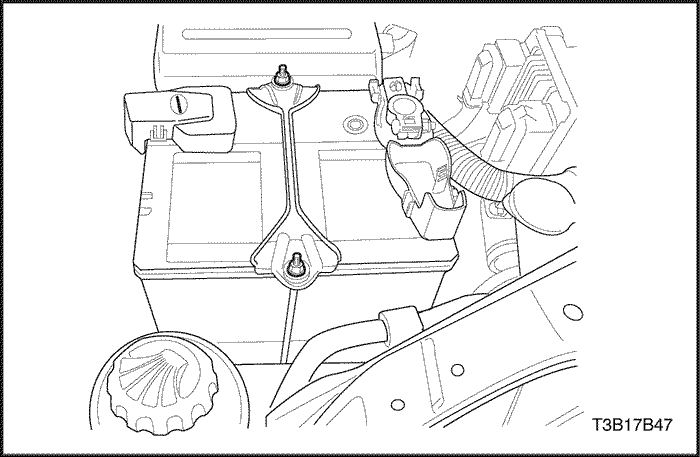


Heater Core
Removal Procedure
- Disconnect the negative battery cable.
- Remove the instrument panel carrier assembly. Refer to Section 9E, Instrumentation/Driver Information.
- Remove the heater/air distribution case assembly. Refer to "Heater/Air Distribution Case Assembly" in this section.
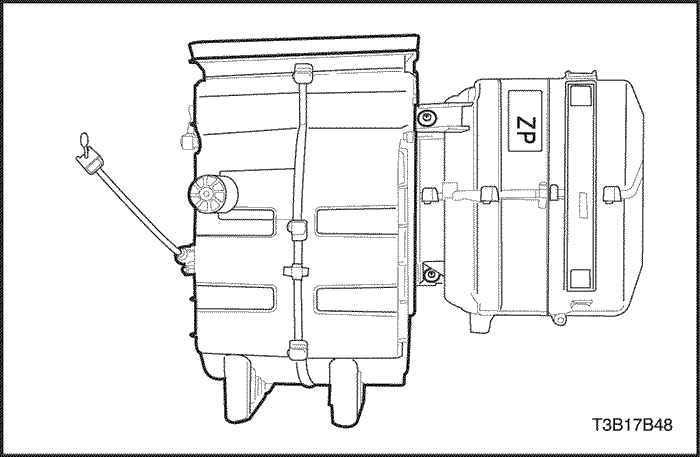


Notice : Handle the case carefully to avoid damage to the linkage levers.
- Remove the heater core from the heater/air distribution case assembly.



Installation Procedure
- Install the heater core into the heater/air distribution case assembly.



- Install the heater/air distribution case assembly. Refer to "Heater/Air Distribution Case Assembly"in this section.
- Install the instrument panel carrier assembly. Refer to Section 9E, Instrumentation/Driver Information.
- Fill the cooling system. Refer to Section 1D, Engine Cooling.
- Connect the negative battery cable.
- Evacuate and recharge the A/C system. Refer to "Discharging, Adding Oil, Evacuating, and Charging Procedures for A/C System" in this section.



Evaporator Core
Removal Procedure
- Disconnect the negative battery cable.
- Remove the instrument panel carrier assembly. Refer to Section 9E, Instrumentation/Driver Information.
Notice : Handle the case carefully to avoid damage to the door actuating linkage.
- Remove the heater/air distribution case assembly. Refer to "Heater/Air Distribution Case"in this section.
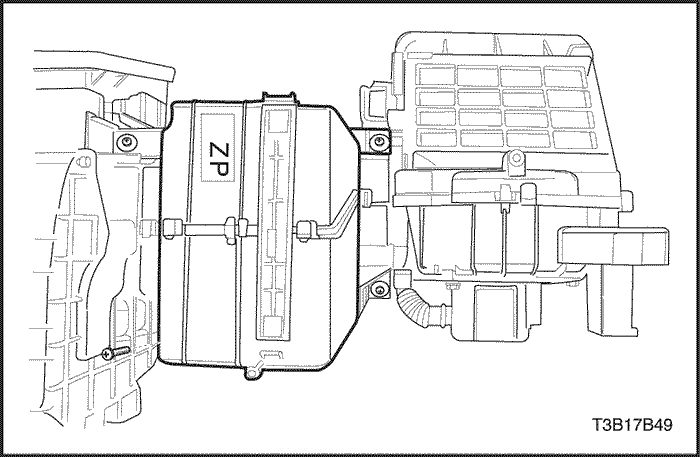


- Remove the screws that secure the evaporator case cover.
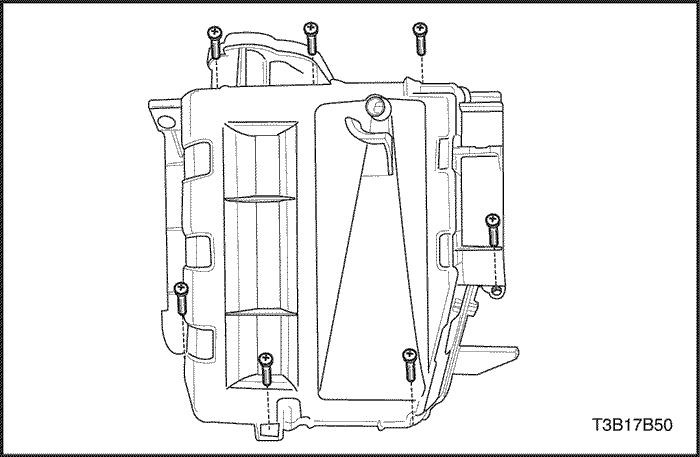


- Remove the cover.
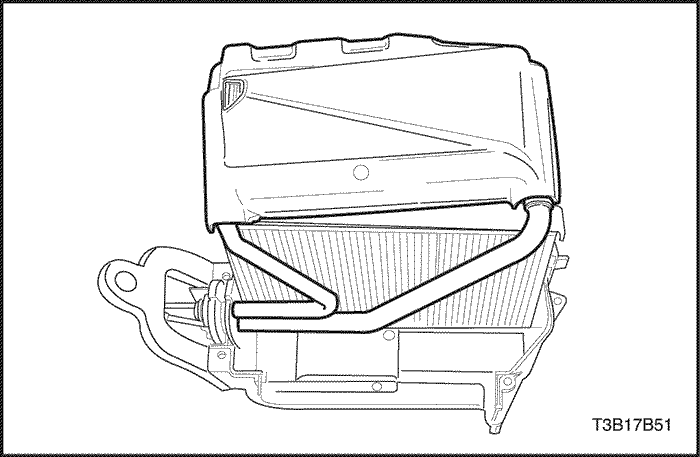


- Slide the evaporator flange support plate upward to facilitate evaporator removal.
- Remove the evaporator from the case.



Installation Procedure
- Install new O-rings onto the evaporator tubes.
- Install the evaporator core into the case. Center the evaporator flange in the case opening.



- Install the evaporator core case cover with the screws.



- Install the heater/air distribution case. Refer to "Heater/ Air Distribution Case" in this section.



- Install the instrument panel carrier assembly. Refer to Section 9E, Instrumentation/Driver Information.
- Connect the negative battery cable.
- Evacuate and recharge the A/C system. Refer to "Discharging, Adding Oil, Evacuating, and Charging Procedures for A/C System"
in this section.



Compressor
Removal Procedure
- Disconnect the negative battery cable.
- Discharge and recover the refrigerant. Refer to "Discharging, Adding Oil, Evacuating, and Charging Procedures for A/C System"
in this section.
- Remove the compressor A/C hose assembly connector block fitting nut. (V5 Compressor shown, SP10 Compressor similar)
- Raise and suitably support the vehicle.
- Disconnect the electrical connector at the compressor.
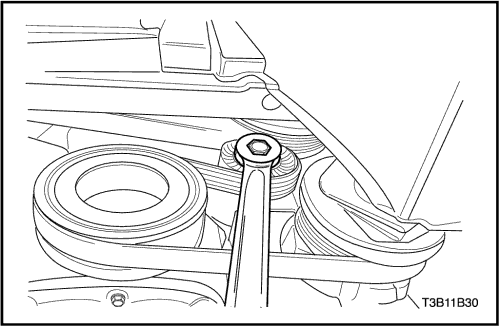


- Remove serpentine accessory drive belt. (V5 System shown, SP10 System similar)
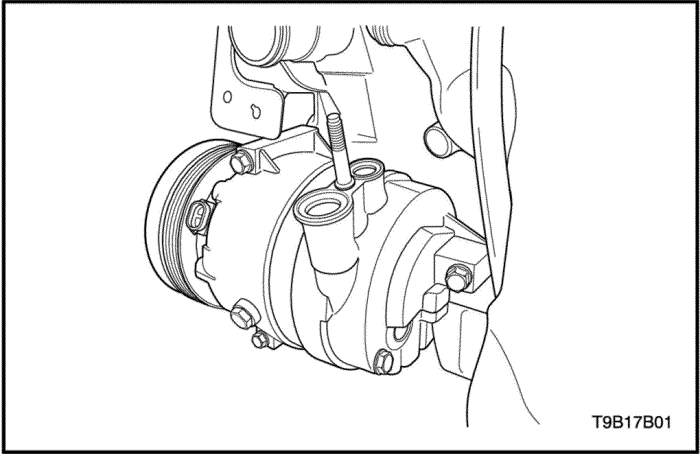


- Remove the A/C compressor-to-bracket bolts. (V5 Compressor shown, SP10 Compressor similar)
- Remove the compressor. (V5 Compressor shown, SP10 Compressor similar)
- Drain the oil from the compressor into a container. Measure the amount of oil drained and then discard the used oil.



Installation Procedure
- Add oil to the new compressor. Use the exact amount of oil that you drained from the old compressor.
- Install the compressor. (V5 Compressor shown, SP10 Compressor similar)
- Install the compressor-to-bracket mounting bolts.
Tighten
Tighten the compressor bracket bolt to 27 N•m (20 lb-ft).



- Install the serpentine accessory drive bolt. (V5 System shown, SP10 System similar)
- Lower the vehicle.



- Install new O-ring to the A/C hose assembly connector block fitting.
- Install the compressor hose assembly connector block fitting and tighten the retaining nut. (V5 Compressor shown, SP10 Compressor similar)
Tighten
- Tighten the A/C system hose connector retaining nut to 33 N•m (24 lb-ft). (V5 Compressor only)
- Tighten the refrigerant suction and the refrigerant discharge hose to compressor block retaining bolts to 33 N•m (24 lb-ft). (SP10 Compressor only)



- Connect the electrical connector at the compressor.
- Connect the negative battery cable.
- Evacuate and recharge the A/C system. Refer to "Discharging, Adding Oil, Evacuating, and Charging
Procedures for A/C System"
in this section.
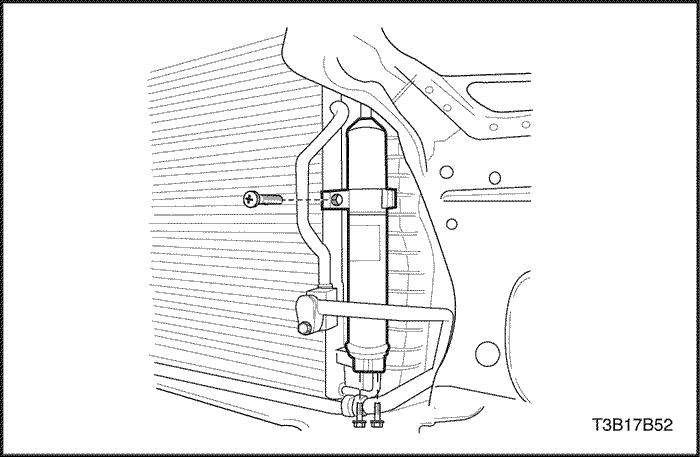


Condenser - With Receiver-Dryer -
Removal Procedure
- Disconnect the negative battery cable.
- Discharge and recover the refrigerant. Refer to "Discharging, Adding Oil, Evacuating, and Charging Procedures for A/C System"
in this section.
- Remove the liquid pipe connector block to condenser retaining bolt.



- Remove the refrigerant discharge hose connector block bolt at the condenser.
- Remove the radiator. Refer to Section 1D, Engine Cooling.
- Cap all the openings to prevent contamination.
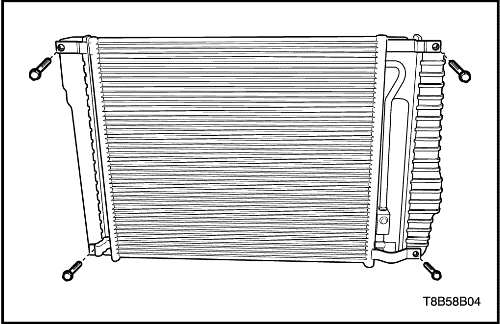


- Remove the condenser mount bolts.
- Remove the condensor from the radiator.



Installation Procedure
Important : Do not reuse the O-ring.
- Install the condenser to the radiator.
- Install the condenser mount bolts.
Tighten
Tighten the condenser mount bolts to 7-10 N•m (62-89 lb-in).
- Install the radiator into the vehicle. Refer to Section 1D, Engine Cooling.



- Install the refrigerant discharge hose connector block bolt at the condenser.
Tighten
Tighten the refrigerant discharge hose connector block bolt to 16 N•m (12 lb-ft).



- Install the liquid pipe connector block to condenser retaining bolt.
Tighten
Tighten the liquid pipe connector block to condenser retaining bolt to 14 N•m (10 lb-ft).
- Connect the negative battery cable.
- Evacuate and recharge the A/C system. Refer to "Discharging, Adding Oil, Evacuating, and Charging Procedures for A/C System"
in this section.
| © Copyright Chevrolet Europe. All rights reserved |


































































